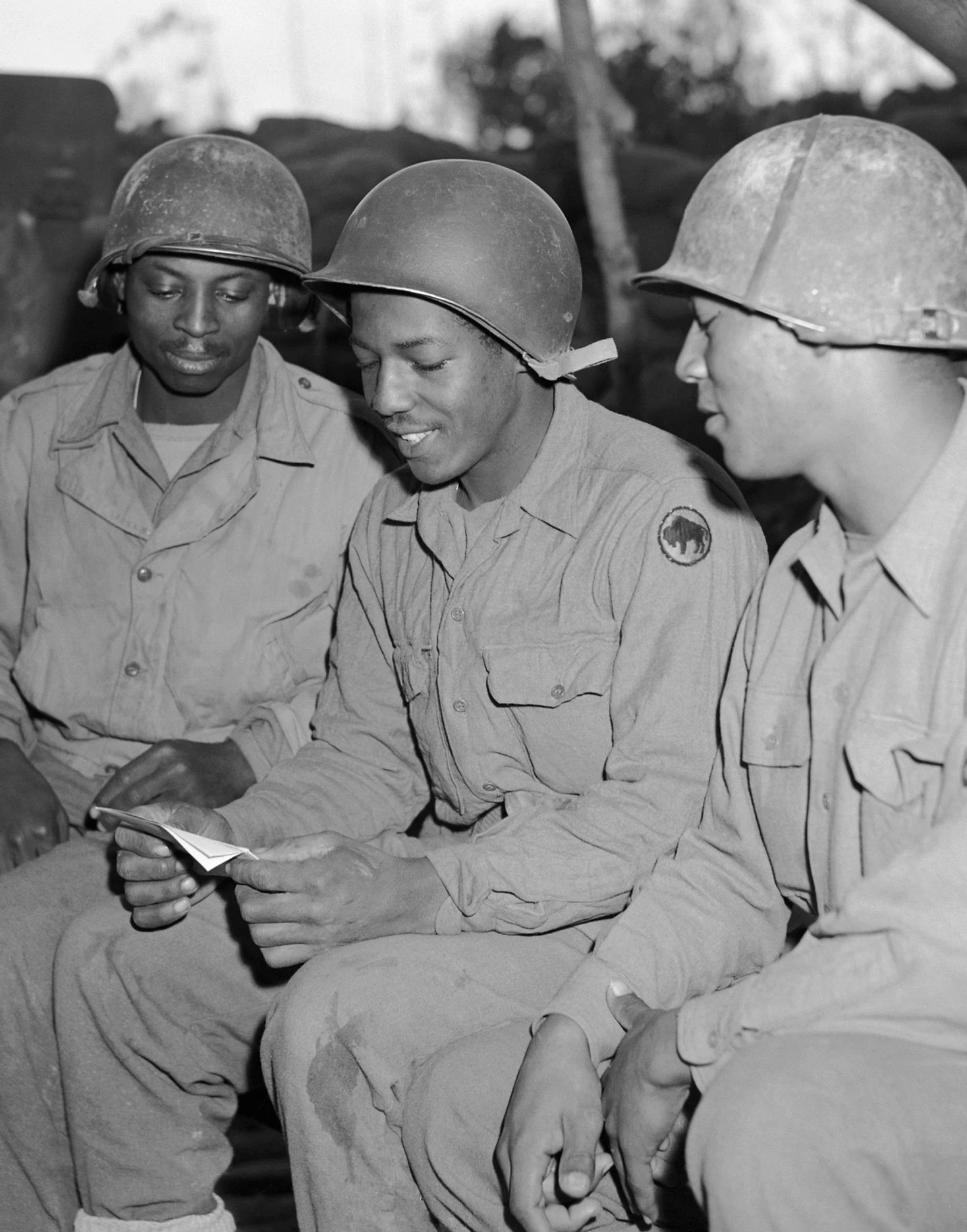Photo by Bettmann Collection/Getty Images
Wearing insignia on their shoulders representing an American bison, the soldiers of the 92nd Infantry Division during World War II carried on the legacy of the “Buffalo Soldiers” who had served with the U.S. Army since the Indian Wars of the 19th century.
Military service historically has been a means to securing full citizenship for marginalized peoples. However, the hold of white supremacy in the United States strangled even this avenue for Black men. Despite their service as far back as the American Civil War, African American soldiers were denied citizenship rights regardless of the enormous difficulties they faced and despite their achievements and sacrifices.
Nevertheless, at the outbreak of World War II, many undaunted African Americans were again willing to demonstrate their valor. The 92nd Infantry Division — a “colored” unit under white leadership — was reactivated on October 15, 1942, and stationed at Fort Huachuca, Arizona.
After nearly two years of training, Buffalo Soldiers like Private Romie Hall, Private John Hogue, and Corporal William Bennet, reading a letter from home in the above photograph, were dispatched to the frontlines in Italy from July to September 1944. They were a welcome arrival for the U.S. Fifth Army, a polyglot international force in dire need of reinforcements after many of its soldiers were redeployed to the new front in Southern France.

Photo by Bettmann Collection/Getty Images
Tasked with covering the left flank of the Allied lines, the 92nd Infantry Division was launched repeatedly against German and Italian positions in the Serchio River Valley by the division’s ambitious commander, Major General Edward Almond. In the heat of Italy’s late summer, these Buffalo Soldiers attacked — not riding horses and wielding Winchester repeating rifles as they had in the past, but, as the photograph above shows, carrying modern and lethal M-1 carbines and rifles, .30 caliber Browning machine guns, and 60mm mortars. Their eyes, however, still reveal the same pride and courage of their ancestors.
Unfortunately, during the offensive, casualties mounted with little gain. Out of a total of about 15,000 men, over 400 soldiers of the 92nd Infantry Division were killed in action, 1,500 were wounded, and almost 500 were missing in action or taken prisoner from October 1944 to the end of February 1945.
Among them, 1st Lieutenant John R. Fox died heroically, as he called in artillery fire on his own solitary position, surrounded by Germans, to cover the withdrawal of the rest of his regiment in Sommacolonia on December 26.
Instead of receiving praise for their courageous efforts, the soldiers of the 92nd Infantry Division were abandoned by their commander and by a skeptical white leadership that never held any faith in their ability to perform on the battlefield.

Photo by Galerie Bilderwelt/Hulton Archive/Getty Images
Records show, in fact, that even before shipment overseas, Maj. Gen. Almond had already decided to blame any disappointment on Black incompetence. More heroic actions — such as Lieutenant Vernon J. Baker’s repeated one-man assaults that neutralized multiple enemy positions at Castello Aghinolfi on April 5, 1945 — did not change the commands’ belief in Black soldiers’ combat ineptitude.
The Buffalo Soldiers’ awareness that their own officers did not believe in them was an important factor that destroyed their morale in the face of the enemy. While court martials, demotions, and transfers ordered by the command were hitting the soldiers of the 92nd, the division was taken off the frontline and consigned to rear-guard and menial duties. As shown in the exceptional color photograph above, Buffalo Soldiers who had led the assault against the Nazi-Fascist enemy with machine guns and mortars were reassigned to mine-clearing duties in Italian towns that other units had liberated.
By the end of the war in Italy on May 2, 1945, the 92nd Infantry Division had suffered almost 3,000 casualties. Though Black soldiers’ acts of heroism went unrecognized at the time, Lieutenants Fox (posthumously) and Baker were awarded Medals of Honor in 1997.
Facing systemic racism in World War II led many veterans to interpret their own military experience as proof that the status quo could not be reformed but only radically changed. Others, however, took pride in their service and the enormous obstacles Black enlistees had faced, obtaining the full integration of the U.S. Armed Forces in 1950.

Learn More:
Hargrove, Hondon B. Buffalo Soldiers in Italy: Black Americans in World War II. Jefferson, N.C.: McFarland, 2003.
Kesting, Robert W. “Conspiracy to Discredit the Black Buffaloes: The 92nd Infantry in World War I.” The Journal of Negro History, Vol. 72, No. 1/2, Winter – Spring, 1987: pp. 1-19.
Krebs, Ronald R. Fighting for Rights: Military Service and the Politics of Citizenship. Ithaca, NY: Cornell University Press, 2006.
Moore, Christopher P. Fighting for America: Black Soldiers – The Unsung Heroes of World War II. New York, NY: Ballantine Books, 2005.
Nalty, Bernard C., Strength for the Fight: A History of Black Americans in the Military. New York, NY: Free Press, 1986.
Parker, Christopher S. Fighting for Democracy: Black Veterans and the Struggle Against White Supremacy in the Postwar South. Princeton, NJ: Princeton University Press, 2009.





